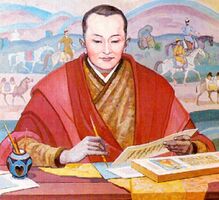Zaya Pandita: Difference between revisions
(Created page with "{{Person |pagename=Zaya Pandita |MainNamePhon=Zaya Pandita |PersonType=Translators |bio=Zaya Pandita or Namkhaijamts (1599–1662) was a Buddhist missionary priest and scholar...") |
No edit summary |
||
| Line 1: | Line 1: | ||
{{Person | {{Person | ||
|MainNamePhon=Zaya Pandita | |MainNamePhon=Zaya Pandita | ||
|OtherNames=Namkhaijamts; Zaya Pandita Namkhai Jamtso | |||
|PersonType=Translators | |PersonType=Translators | ||
|bio=Zaya Pandita or Namkhaijamts (1599–1662) was a Buddhist missionary priest and scholar of Oirat origin who is the most prominent Oirat Buddhist scholar. Among his accomplishments is the invention of the Clear Script. | |bio=Zaya Pandita or Namkhaijamts (1599–1662) was a Buddhist missionary priest and scholar of Oirat origin who is the most prominent Oirat Buddhist scholar. Among his accomplishments is the invention of the Clear Script. | ||
| Line 19: | Line 19: | ||
|yearbirth=1599 | |yearbirth=1599 | ||
|yeardeath=1662 | |yeardeath=1662 | ||
|pagename=Zaya Pandita | |||
}} | }} | ||
Latest revision as of 13:27, 6 October 2023
| PersonType | Category:Translators |
|---|---|
| MainNamePhon | Zaya Pandita |
| bio | Zaya Pandita or Namkhaijamts (1599–1662) was a Buddhist missionary priest and scholar of Oirat origin who is the most prominent Oirat Buddhist scholar. Among his accomplishments is the invention of the Clear Script.
Zaya Pandita was the fifth son of Babakhan, a minor Khoshut prince. After Babakhan converted to Tibetan Buddhism in the early 17th century, he, like many other Oirat princes, wished for one of his sons to enter the Buddhist clergy. In pursuit of his wish, Babakhan chose Zaya to become a śrāmaṇera ("novice monk"). In 1615, Zaya journeyed to Lhasa where he would study and practice Buddhism, including study under the guidance of the Lobsang Chökyi Gyaltsen, 4th Panchen Lama. In 1638, Zaya Pandita left Tibet at the direction of the Panchen Lama to conduct missionary work among the Mongols. One year later in 1640, he assisted Erdeni Batur, Khun Taiyishi of the Choros (Oirats) tribe, in assembling a pan-Mongol conference between the Oirat and the Khalkha Mongols. The purpose of the conference was to encourage the formation of a united Mongolian front against potential external enemies, such as the Kazakhs, Manchus, and Russians and to settle all internal matters peacefully. The conference produced a code, which provided protection from foreign aggression to both the Oirat and the Khalkha and guaranteed the free movement of people throughout Mongol land. When not engaged in diplomacy between the Oirat and the Khalkha, Zaya Pandita spread Tibetan Buddhism to the Oirats, the Khalkha and even the Kalmyk people in far away Russia. In furtherance of his missionary work, Zaya Pandita composed a new alphabet, based on the traditional Mongolian alphabet, called "Clear script" (todo bichig) to transcribe the Oirat language as it is pronounced. By doing so, Zaya Pandita eliminated the ambiguities of the traditional Mongolian alphabet. From the time Zaya Pandita developed the Clear Script in 1648 until his death in 1662, he translated approximately 186 Buddhist texts from Tibetan language to the Oirat language while still serving the religious needs of the Oirat tribes in Dzungaria. The todo bichig script is still used by Oirats in Xinjiang with slight revisions, and is taught alongside standard classical written Mongolian in that region. (Source Accessed Oct 6, 2023) According to Fredrick Liland, "The Oirat scholar Zaya Pandita (1599-1662) according to his biography made a new translation of the BCA. Zaya Pandita was influential in spreading the Buddhist faith also among the Kalmyks, a Mongolian people who migrated to the shore of the Caspian Sea in the 17th Century. He is said to have translated a large number of texts into the Oirat/Kalmyk language, so it is quite likely that the BCA was among these. The translation of Zaya Pandita has however not been found. (Source: Liland, Fredrik. "Later Editions and Translations." In "The Transmission of the Bodhicaryāvatāra: The History, Diffusion, and Influence of a Mahāyāna Buddhist Text," 49–58. MA thesis, University of Oslo, 2009.) |
| YearBirth | 1599 |
| YearDeath | 1662 |
| Other wikis |
If the page does not yet exist on the remote wiki, you can paste the tag |

